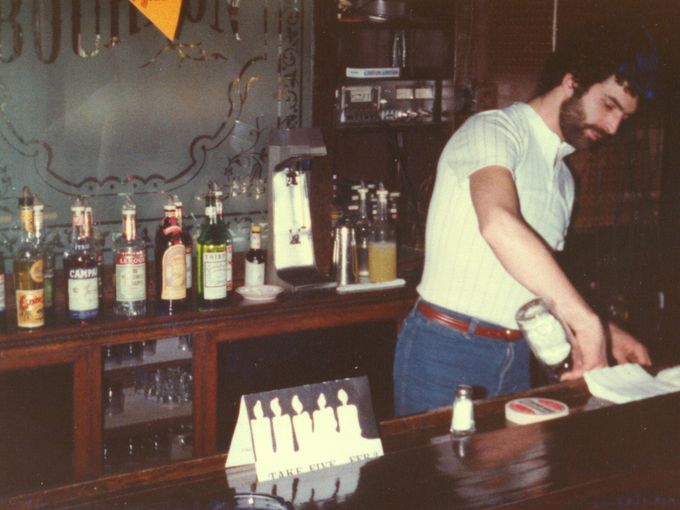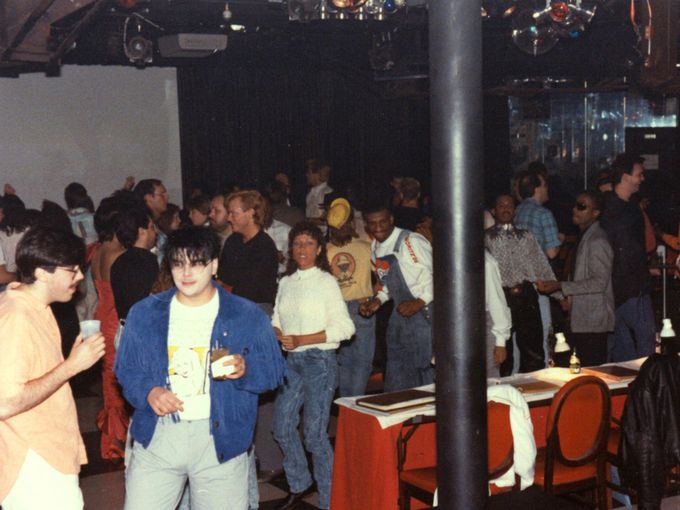
The Hunt and Chase, an Indianapolis gay bar.
The slash represents the closing of the establishment in 1985.
Gay Bars
By the end of the 1930s, with the tightening of what it meant to be “homosexual” and “heterosexual,” bars that served exclusively gay men and lesbian women began to spring up rapidly in American cities.1 Indianapolis, a city of over 700,000 people by the time of New York's Stonewall Riots in 1969, was no exception. In fact, the Hoosier capital could boast more gay bars than most of her surrounding urban neighbors, over a dozen by 1970. Cincinnati and Columbus, Ohio, had just two gay bars each. As Michael Bohr, founder of the Chris Gonzalez Library and Archives noted "Even way back then there was a lot going on [in Indy]."
Gay bars in Indianapolis served not only as meeting spots for gay men and women, but also sites where the gay community could be shielded from societal harassment, especially because most gay bars had no windows. "People years ago wouldn't have been comfortable with windows," said Steve Warman, a longtime Indy Bartender. “They'd be afraid people would shoot them … or see them."
Some Indianapolis establishments were widely known. The Hunt and Chase, which opened in 1975, was listed in the popular gay men’s magazine Blueboy as one of the top ten discos in the United States. Serendipitously opened at the dawn of the disco craze, the club’s mega sound equipment controlled by dee-jay Turtle and posh décor made it popular with locals and visitors alike. As Indianapolis local Mary Byrne remembered, "It was the bar of bars. It was where I learned to dance [and] where I 'came out.”2
 Don Wagner bartends at the Hunt and ChasePhoto courtesy of the Chris Gonzalez Library and Archives
Don Wagner bartends at the Hunt and ChasePhoto courtesy of the Chris Gonzalez Library and Archives Community Debt
The Chase’s owner, Fred Cooney, helped fundraise for local gay rights organizations like the Gay People’s Union (more about the group in the politics exhibit) and worked to better the often-tense relationship between the city’s law enforcement and the gay community.3 Cooney and Mike Bohr also helped lead the Greater Indianapolis Gay Business Association (GIGBA), dedicated to promoting the interests of gay and lesbian businesses within the city. Gay bars, with their obvious connection to the community, were staples of the association. In 1985, GIGBA President Bohr pushed to get free condoms and safe sex literature in all gay bars and bathhouses in the city in an effort to stop the AIDS crisis. “We owe it to [our patrons] and to ourselves to do whatever we can to limit the spread of AIDS,” Bohr explained.4
 By the 1980s, the 21 Club had taken the reigns as the “go to” Indianapolis gay bar.Photo courtesy of the Chris Gonzalez Library and Archives
By the 1980s, the 21 Club had taken the reigns as the “go to” Indianapolis gay bar.Photo courtesy of the Chris Gonzalez Library and Archives
1. George Chauncey, Gay New York: Gender, Urban Culture, and the Making of the Gay Male World, 1890-1940, 358-359. ↩
2. Will Higgins, "Gay Bars in Indianapolis: A Brief History," IndyStar, November 26, 2014. http://www.indystar.com/story/life/2014/11/26/gay-bars-indianapolis-gay-history/19531515/↩
3. Tom Green, Jr. "Paradise Lost..." The Works, October 1982, pg. 8 http://indiamond6.ulib.iupui.edu/cdm/ref/collection/GonzalesLib/id/4273↩
4."GIGBA Wants Free Condoms at All Bars and Gay Health Clubs in Indiana," The Works, September 1985, pg. 13, http://indiamond6.ulib.iupui.edu/cdm/ref/collection/GonzalesLib/id/3369↩